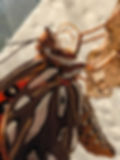"J Shape" Caterpillar Fell
- Jessica Morgan McAtee
- May 7
- 4 min read
"Plant a butterfly garden", they said, "it will be fun!" At it is extremely rewarding, but it is not without its challenges. When raising butterflies, lots of obstacles arise. From predators to disease to loss of host plant leaves, there is plenty of peril for our little flying friends. Sometimes we can help them, but other times the odds are too high against them. Wisdom helps us discern the difference. The struggle is real.
If you feel compelled to help butterflies, please read on. Every little thing we do in love matters.
Recently, someone gifted me a host plant that had a "J Shape" caterpillar dangling from it. For new members of the butterfly-crazed-society, that is code speak for a butterfly in the brush-foot family that is just about to molt its skin for the final time to become a pupa (chrysalis). Monarchs are part of this family, but there are many others too.
This photo story is about a Gulf-Fritillary.
After a caterpillar has eaten its fill, it attaches itself to a substrate by forming a silk pad and then hooking its hind end into it. Its body will curve into a "J Shape" and it will start to change color as its insides begin to breakdown and it prepares for a final molt of the caterpillar skin.

Butterflies are extremely vulnerable in-between molts. They cannot relocate themselves once this process is triggered. They are in a trance-like state where their hormones are running the show and causing major transformation. It is important that they are not touched during this time because their exoskeleton is fragile.
When they form their chrysalis (by a final caterpillar skin molt), the chrysalis serves as a mold for the butterfly form. Therefore, it is critical that the chrysalis (pupa) is formed perfectly because the liquid butterfly will fill that mold and a damaged pupa will result in a damaged butterfly.
For the brush-foot family of butterflies, they ensure a perfect pupa by hanging themselves in a place where the chrysalis can form properly...but occasionally they become dislodged and here is today's peril.
When the aforementioned host plant was given to me, the "J Shape" caterpillar fell from its silk pad and landed on the seat of the car. The caterpillar looked like the one in the photo, and discoloration had begun. It was still in its "J" and I knew this was not a good situation. I had to think fast.
For starters, the caterpillar can not "walk" anymore once it is in a discolored "J." This means it cannot build another silk pad and reattach itself. It is gearing up for a molt, and touching it can cause damage. So, I softly and quickly placed it on the bottom of a cupcake container (any little container will do) and allowed it to shed its skin while laying on its side.
Having it shed while laying on its side is NOT a great option, because the soft new chrysalis will form on its side which will deform it. But it was the best option I had.
I left it in the container overnight.
In the morning, as expected, it had shed its skin and become a pupa, with slight deformation since it was laying on its side after the "J Shape" caterpillar fell. Once it is a hardened chrysalis (a couple of hours after the molt), it is safe to touch. It was obvious that the chrysalis was not perfectly symmetrical, especially around the head area.

From there, I attached it with a low temp hot glue gun to the top of the cupcake container, as I normally do with chrysalises. The plan was to wait and see if it emerged a healthy butterfly, or if it would be too deformed to fly, due to pupating on its side.
Lo and Behold! It emerged a healthy butterfly. I especially paid attention to its head area since that is where the chrysalis was noticeably deformed.

After it "zipped together" the two sides of its healthy proboscis (its straw-like mouth part), it dried its wings normally while dangling from its empty pupa.
Eventually, I took it outside and released it, celebrating a happy ending.

That story happened to end well, but not all of them do. Sometimes, the damage from the "J shape" caterpillar fall is permanent. If the fall doesn't kill them, and if you allow them to pupate on their side, they may not form correctly. There is only so much we can do, so don't beat yourself up if you cannot save it. It is not always necessary to reattach them (the way I did), but I felt this one had already been through a rough time so I wanted to increase the odds of surviving. A chrysalis can emerge while laying down, but it is a bit more complicated and I have other posts about that if you are in that space.
If you are new to raising butterflies, I recommend my free online course on butterflies so that you understand the butterfly story in its full context.
Thank you for taking the time to care for a butterfly.
Every little thing done in love matters,
Jessica
